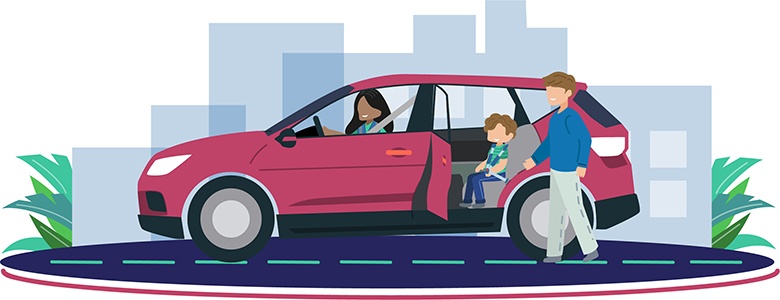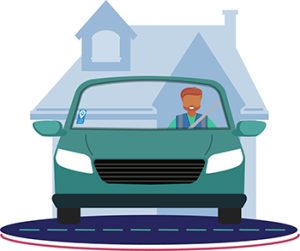
In the effort to continue educational access for students across the United States, student transportation as an industry has shifted to become more inclusive of small-capacity vehicles. Adapting to the needs of today’s students requires a departure from strictly using the traditional school bus model, allowing districts greater flexibility in both routing and catering to individual transportation requirements. The shift towards more small-capacity supplementation is a direct result from the changes in school populations, the increase in school choice, the rise in chronic absenteeism, the growing prevalence of Individualized Education Programs (IEPs), the recent increase of bus driver shortages, and recent decrease in Commercial Driver’s Licenses (CDLs).
Student transportation and the needs associated with its management are evolving from getting students from point A to point B, to doing so in a way that caters to the unique demands of the contemporary educational institution. Alternative transportation, small-capacity vehicles and their drivers, has emerged as a solution, providing districts with the adaptability needed to navigate complex routing and service challenges.
Unfortunately, however, alternative models of student transportation are scarcely regulated. Recognizing the importance of small-capacity vehicles and understanding how important it is to focus on the safety required to drive those vehicles, is crucial in fostering a secure transportation system for students across the country. To ensure a robust, modernization of student transportation through alternative options, districts, counties, and states must comprehensively update student transportation standards in their Requests for Proposals (RFPs), safety requirements, and regulatory and legislative frameworks.
Adapting to Change: Ensuring Safety Through Regulation
State regulation surrounding alternative student transportation either does not exist, or if it does exist, it is outdated.
Alternative transportation, unlike the traditional yellow school bus, is not so standardized of a model from company-to-company. Some companies are transportation management companies that partner with transportation companies local to the area of service, and some companies are transportation network companies contracting directly with drivers local to the area of service. In both models the driver is typically transporting students in their own personal vehicle.
 States that recognize alternative transportation in law often require vehicles to be registered at the state level as a ‘school vehicle,’ necessitating special license plates or permanent vehicle modifications. In more extreme cases, the alternative vehicle must be owned by the school district or driven by a school district employee. Requirements like these originate from a time where one or two alternative vehicles were used in a district’s transportation plan, but with all the challenges districts are presented with in present day, the need for alternative student transportation models where a driver transports students in their personal vehicle is significant. State requirements limiting personal vehicle usage to a single transportation option is impractical and prohibits the possibility of greater routing flexibility districts desire in today’s educational environment. Rightsizing vehicle requirements is just one way to decrease a district’s transportation burdens for student populations that might not necessarily be able to utilize a traditional bus route.
States that recognize alternative transportation in law often require vehicles to be registered at the state level as a ‘school vehicle,’ necessitating special license plates or permanent vehicle modifications. In more extreme cases, the alternative vehicle must be owned by the school district or driven by a school district employee. Requirements like these originate from a time where one or two alternative vehicles were used in a district’s transportation plan, but with all the challenges districts are presented with in present day, the need for alternative student transportation models where a driver transports students in their personal vehicle is significant. State requirements limiting personal vehicle usage to a single transportation option is impractical and prohibits the possibility of greater routing flexibility districts desire in today’s educational environment. Rightsizing vehicle requirements is just one way to decrease a district’s transportation burdens for student populations that might not necessarily be able to utilize a traditional bus route.
Similarly, states that recognize alternative transportation in law today typically require drivers to receive a CDL (Commercial Driver’s License) or a bus permit on top of their non-commercial driver’s license. Drivers of student transportation of any kind certainly need to be educated on safe driving practices, defensive driving, student behaviors, securements, and emergency protocols and equipment, but they do not need to know how to properly drive a school bus. That said, it is still vital to maintain essential safety measures such as background checks, physical health assessments, substance abuse checks, and continued education. By considering the right driver and vehicle requirements without compromising safety, we can ensure the well-being of students, regardless of the vehicle size.
States that do not recognize alternative transportation have the opposite problem. While school buses and their drivers undergo stringent vetting processes, alternative vehicles and their drivers often lack the same level of scrutiny. This regulatory gap poses a potential threat to student safety and introduces unwarranted variations in standards across districts and contractors.
Districts, counties, and states must take an active role in rightsizing safety standards for alternative student transportation. Where laws and regulations do not exist, they need to be created, and in some cases where they do exist, the laws and regulations need to be reevaluated with a more common-sense approach.
Proposed statutory or regulatory changes should not be viewed as a departure from safety but rather as an opportunity to redefine and enhance what safety looks like at a state level. Student safety is the number one priority, so it is crucial to advocate for right-sized regulations that align with the specificities of small-capacity vehicles that could better meet the needs of the district and the student.
Legislative Trailblazers: Paving the Way for Safety
Over the past three years, several states, including Indiana, Georgia, Maryland, Illinois, and California, have passed legislation to establish common-sense safety standards for alternative transportation at the state level.
These laws represent a significant step towards closing regulatory gaps and ensuring that safety standards align with the changing landscape of student transportation.
The success of these legislative efforts relies on finding the right balance between modernization and safety. As states work towards establishing safety standards for alternative transportation, they must carefully consider the unique challenges and opportunities posed by small-capacity vehicles and their drivers, such as transporting in personal vehicles and operating those personal vehicles with driver’s licenses for passenger vehicles. The legal framework should promote flexibility and adaptability while maintaining an unwavering commitment to student safety.
Though right-sizing regulation is a logical response to industry growth, legislative initiatives have tried, sometimes successfully, to remove the oversight of state agencies responsible for student transportation regulation from certain alternative transportation models. All alternative student transportation should be regulated by the same state agency, regardless of the way their business is structured. Having multiple agencies involved or allowing for certain business models to operate outside of standardized regulations leads to confusion and complexity.
In the ever-changing landscape of student transportation, small capacity supplementation makes sense. It promotes the continued goal of the educational community for equitable access to education for students no matter their unique circumstances. It also can promote and exemplify the safety society has come to expect and depend on within the industry, if it is recognized and right sized at the state, county, and district level.
This modernization in student transportation requires an unwavering dedication to the well-being of the students who rely on these vital services, while working towards a way to expand the services that are offered and keep safety top of mind. As new and existing regulatory frameworks are created or reviewed, the principles of rightsizing and flexibility should be considered, with the goal being consistency and continuity of safety standards across the student transportation industry.


